You will with EVGA’s Nu Audio Pro Surround boards.

AAA games, especially FPS games have amazing 3D models, and graphics and, equally amazing sound usually with unique (and not inexpensive) soundtracks, voice overs, and special effects. If you don’t have a good sound system, you’ll never hear them.
The DACs and decoders on the motherboard and in the CPU or GPU are pretty good, but average—like integrated graphics, good enough for the average person—but not good enough for the gaming enthusiast. To pluck the real richness out of the sound tracks, you need a super high sample rate and a lot of bits, 24 minimum.
The whole idea is to get as close as possible to a pure analog sine wave as possible—that’s the nuance of fidelity. New Orleans based audio electronics company PreSonus offers useful backgrounder on the topic on their site.

After you get the digitization and before the digital to analog conversion is accomplished, you have to decode the data into the proper channel, and there are eight possibilities: front left and right, center, side left and right, back left and right, and sub-woofer. And, if you want to reproduce the sound with the correct physiological reproduction, you have to position the speakers correctly too.
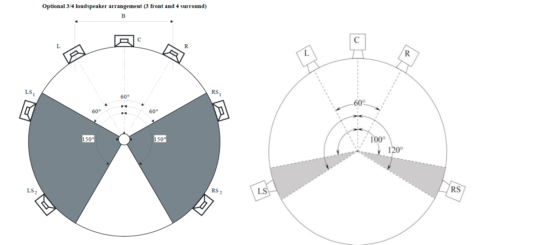
If you don’t have a sound board, you have to use the line out from the motherboard, which can be in the form of a PCM output via a 3.5 mini pin, or optical port on the rear panel. The basic specification is AC’97 (Audio Codec ’97), an audio codec standard developed by Intel Architecture Labs in 1997. AC’97 defines a high-quality, 16- or 20-bit audio architecture with 5.1 surround sound support for the PC. The sample rate is typically 16-bit, 44.1 KHz.
Games that have noteworthy sound design are: Assassin’s Creed Revelations and 3, Battlefield (series), BioShock, Dead Space, Far Cry 5, Her Story, Portal2, Rage., That Dragon, Cancer, The Sims, Witcher 3, and several others. There’s a discussion of some game music composers here and here.
That audio is an important factor in gaming, exemplified in a 2012 study that measured the heart rate of players with and without audio. The heart rate was higher in the group that had audio indicating involvement and excitement.
So, if you are a fan of good-to-great audio, then you should get a sound board to give you the most you can get. With that goal in mind, we tested EVGA’s Nu Audio Pro Surround boards. Yes, boards. The main board gives you 2-channel stereo and earphone outputs, plus 5.1 PCM via the optical port, and the companion board adds 7.1 center and sub-woofer.
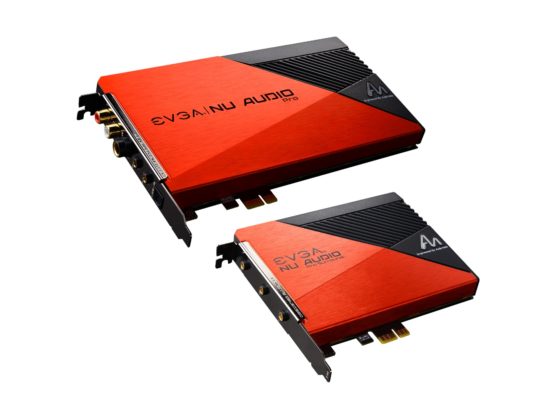
The EVGA NU Audio Pro boards represents EVGA’s pursuit of audio perfection in a PC. That may sound like a PR or marketing throw-away line, but it isn’t. Andrew Han, president and founder of EVGA is an absolute maniac of an audiophile. I’ve been privileged to see his home setup and can say it is the most elaborate system I have ever encountered with speakers bigger than I am, vintage vacuum tube amplifiers, and the finest (and I mean THE finest) turntables available. He’s still young enough to also be able to hear the amazing sounds his system produces (my ears are a little older and like everyone, I have lost high frequency sensitivity). I mention the CEO’s fanatical enthusiasm for audio because that is the users’ best guarantee you could have. There is no way Mr. Han is going to let an audio device go out with an EVGA name on it that isn’t as perfect as one can be made. For example, EVGA uses Seiryu audio capacitors, a premium combination headphone pre-/power amp, and a carefully crafted cover and backplate to block EMS. I also happen to know that these boards were in development for over three years.
EVGA has a couple of sound boards, and the Nu Pro Surround is the newest 7.1 Surround solution from the company. The NU Audio Pro 7.1 delivers an aural overload of 7.1 analog surround for the most immersive audio experience available for the PC that we’ve found so far.
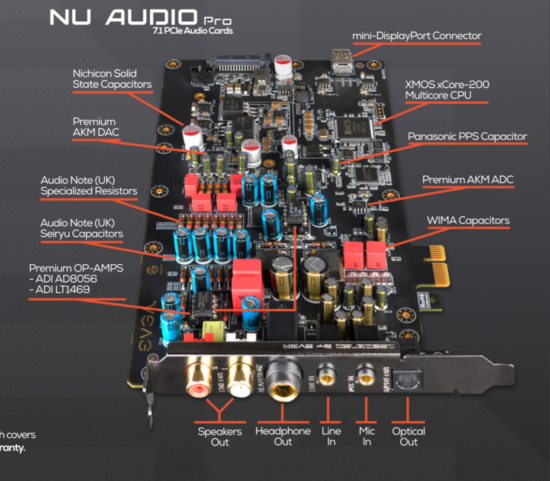
The overall specifications are impressive in and of themselves.
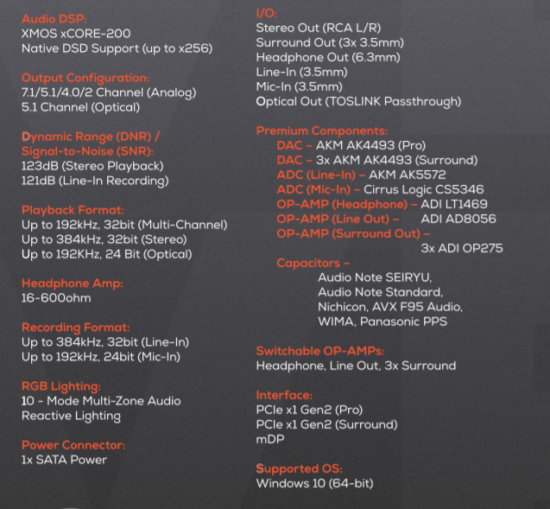
The NU Audio Pro Surround companion board brings an extra 6 channels to the NU Audio Pro main board to deliver the full 7.1 analog surround.
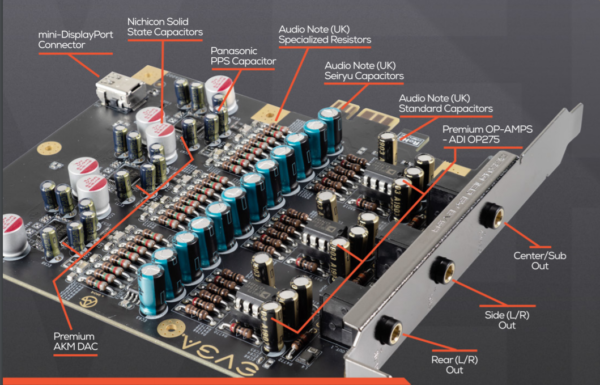 Inside the companion 7.1 Nu Audio Pro Surround board.
Inside the companion 7.1 Nu Audio Pro Surround board.

EVGA’s software includes a great user interface that comes with it that gives users complete control over their audio setup, including Nahimic 3D Audio for gamers and full control over the multi-zone RGB lighting on the board. The Nahimic audio is built into EVGA’s driver, so you don’t have to download or install any additional software.
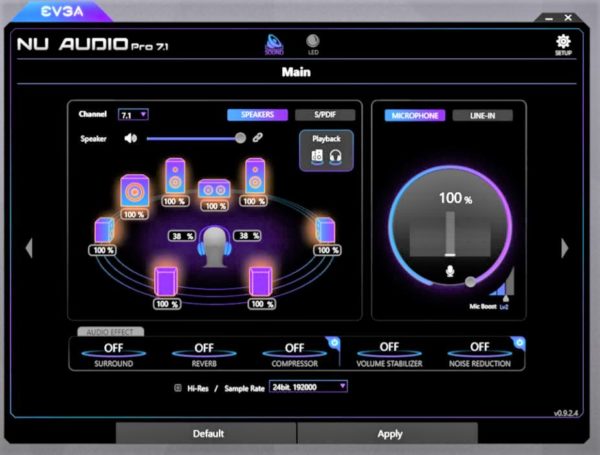
The analog outputs from the two boards are signal level and not speaker lines. The boards require an amplifier and speakers, or a high-quality set of headphones.
If you are happy with just 5.1 sound, you can use the optical output connector to your amp. If you don’t have an optical input to your amp, then you will use the individual connectors on the two boards for each channel.
EVGA has also provided a useful FAQs and glossary. For example, if you wanted to know how good the audio quality of your source is, it’s easy to tell the audio track quality by looking at the bit rate. CDs, for example, are ripped to different bitrate formats. For example:
- 128 kbps—lower quality MP3 format (lossy)
- 320 kbps—higher quality MP3 format (lossy)
- 1411 kbps—FLAC/WAV (lossless)
To find the bitrate, just right-click on the music file and click Properties. After you find out, then, via the UI (above), select the appropriate sample rate and bit-depth. If the sampling rate of your media does not match your default format, it will be re-sampled by Windows. The Windows re-sampler is of mediocre quality so it’s best to set the sampling rate to match your media.
OK, you want one. Go find $300 and you can get the set, or separately the main board for $199 and daughter board for $119.
What do we think?
I had been playing Fallout 76, Tom Clancy’s Ghost Recon, Halo Reach, and Wolfenstein Youngblood, and Red Death Redemption with stereo speakers and a sub-woofer, running basic AC97. I thought it sounded OK, in fact good. Ha. Little did I know. I dusted off a 10-year old Creative Labs 5.1 amp and speakers, and hooked it all up, using the optical port. First thing I learned was my old amp couldn’t get above 96,000 bit rate, so I set it at 24-bit, 96,000. And then I heard things I had never heard before from the games. It was shocking, delightful, and a bit distracting. The voices in the dialogs were crisper and more distinct, and the weapon’s sound were quite different. Background music was richer, and more interesting. Now I’m trying to find a reasonably priced 32-bit, 485 KHz, 7.1, 3 Ohm speaker amp to see, ah, hear, what I’m missing.





